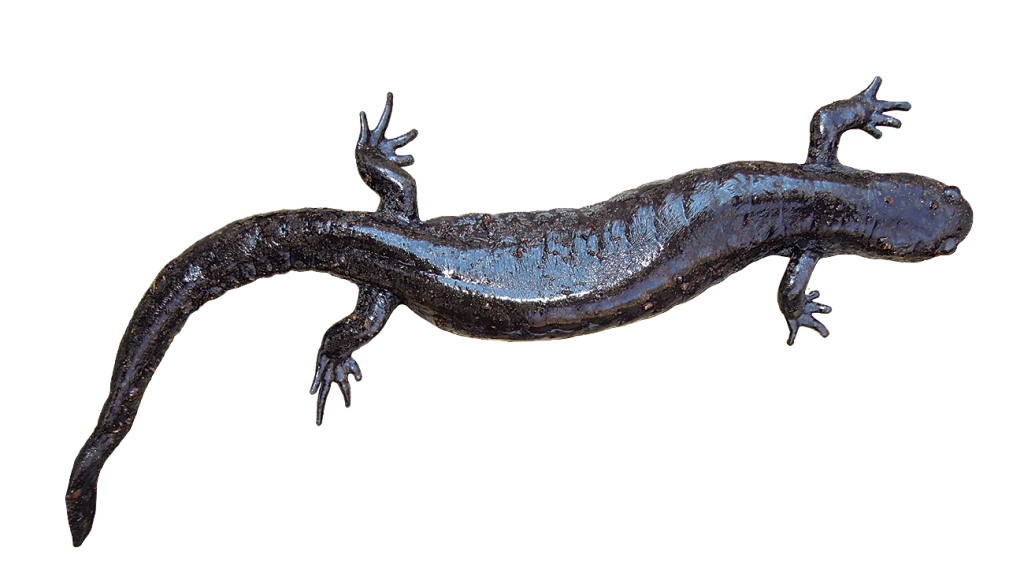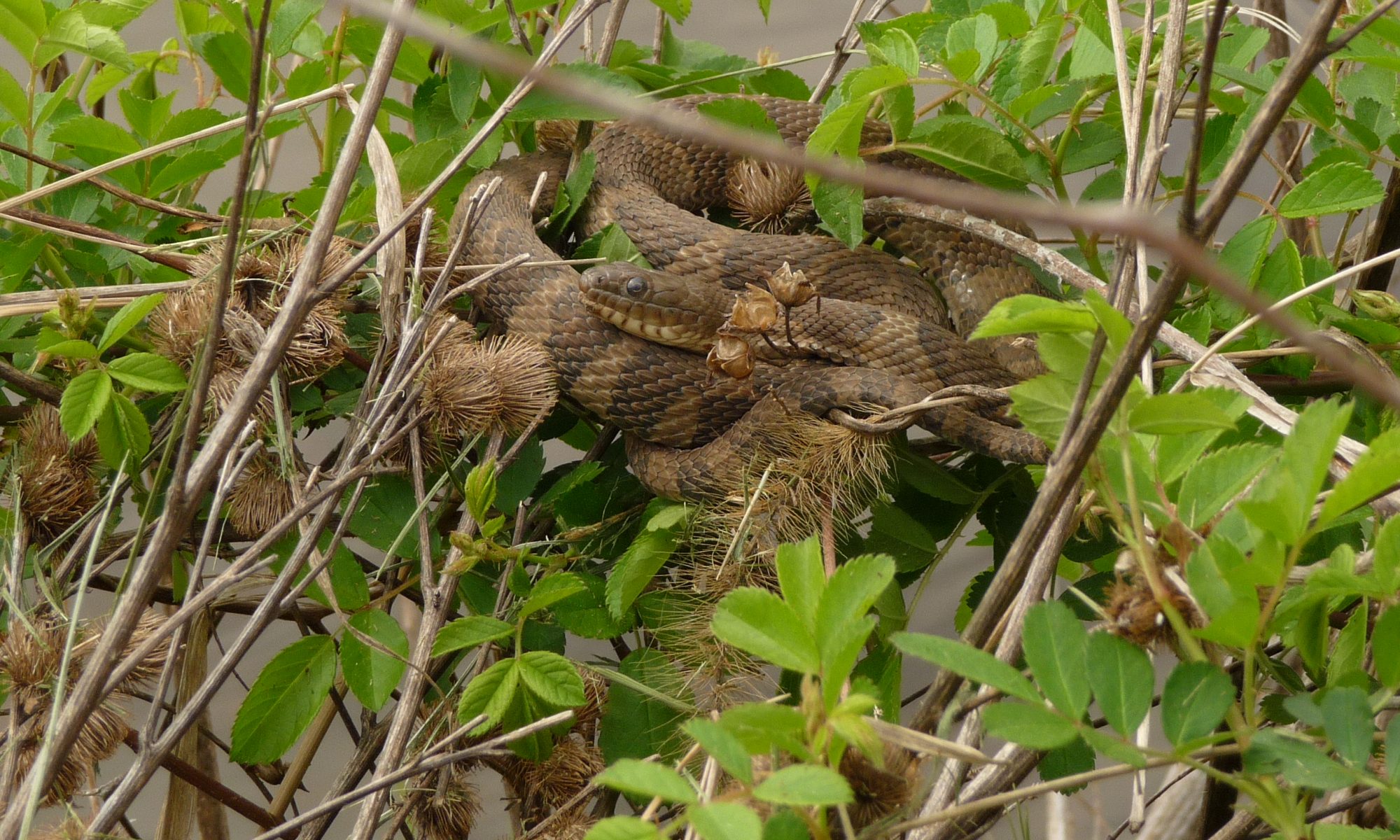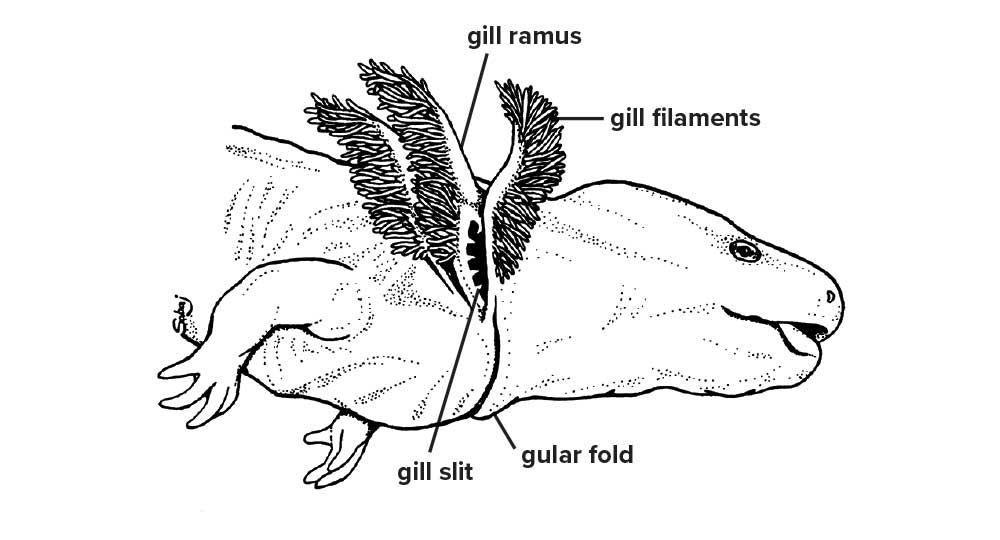
1a. External gills absent … 2
1b. External gills present (Fig. 2) … 19
2a. Gill slits (Fig. 2) number 1 pair; eyelids absent (body wrinkled and flattened, with a fold of skin along each side; a flap of skin on the trailing edge of each leg) … Hellbender
2b. Gill slits (Fig. 2) absent; eyelids present … 3
3a. Nasolabial grooves (Fig. 3) present … 4
3b. Nasolabial grooves (Fig. 3) absent … 11
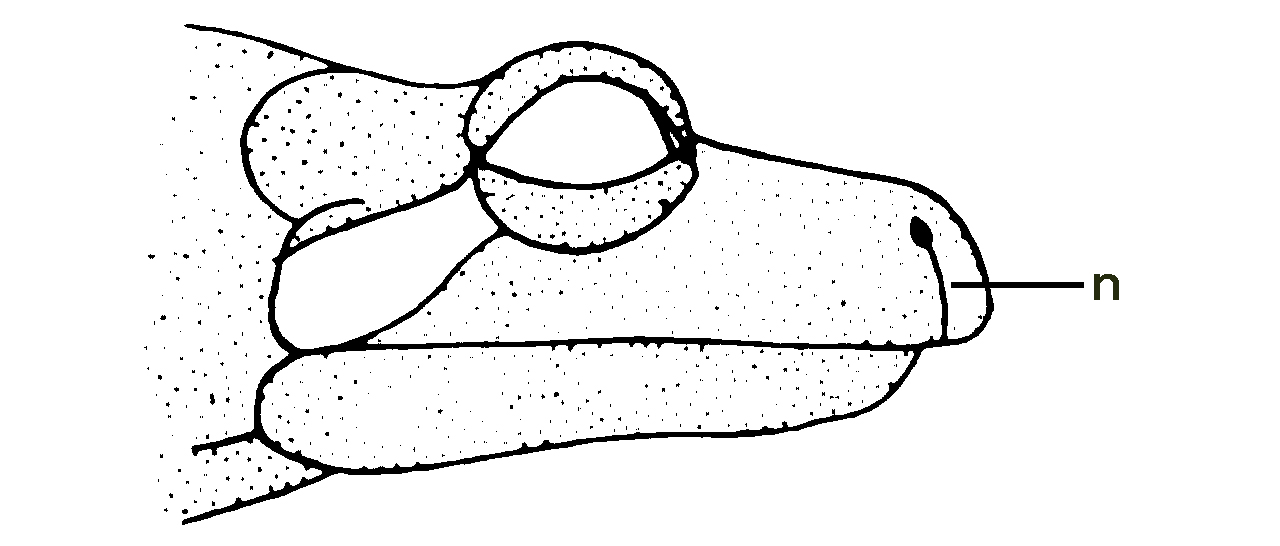
4a. Hind foot with 4 toes; base of tail constricted; venter white with black spots … Four-toed Salamander
4b. Hind foot with 5 toes; base of tail not constricted; venter not white with black spots … 5
5a. Light line from eye to angle of jaw … Spotted Dusky Salamander
5b. Light line from eye to angle of jaw absent … 6
6a. Ground color of body yellow, tan, orange, or red; venter white, orange, or yellow … 7
6b. Ground color of dorsum and venter dark gray, brown, or black … 9
7a. Costal folds number 3 or more between adpressed limbs (Fig. 4); dorsum with pair of dark brown stripes … Two-lined Salamander
7b. Costal folds number 2 or fewer between adpressed limbs (Fig. 4); dorsum without brown stripes … 8

8a. Ground color of body orange or red; dorsum with scattered black spots; sides of tail with scattered black spots … Cave Salamander
8b. Ground color of body yellow or orange-yellow; dorsum with clustered black spots; sides of tail uniformly dark or with dark vertical zigzag bars … Long-tailed Salamander
9a. Dorsum black with small white spots … Northern Slimy Salamander
9b. Dorsum dark gray with fine white stippling or with a yellow-to-red mid-dorsal stripe … 10
10a. Tail usually longer than snout-vent length; mid-dorsal stripe, if present, always straight-edged; upper front legs without orange or red pigment … Eastern Red-backed Salamander
10b. Tail usually shorter than snout-vent length; mid-dorsal stripe, if present, straight-edged or zigzag; upper front legs with orange or red pigment … Northern Zigzag Salamander
11a. Costal grooves absent; gular fold (Fig. 2) absent … Eastern Newt
11b. Costal grooves present; gular fold (Fig. 2) present … 12
12a. Dorsum dark with white or silvery crossbands … Marbled Salamander
12b. Dorsum dark, but without white or silvery crossbands … 13
13a. Dorsum with yellow or orange spots … 14
13b. Dorsum without yellow or orange spots … 15
14a. Dorsum with circular yellows pots of nearly equal size and in 2 rows; venter uniformly dark gray … Spotted Salamander
14b. Dorsum with irregular yellow spots of unequal size, not organized into rows; venter usually marked with yellow spots … Eastern Tiger Salamander
15a. Costal grooves (Fig. 5) number 10-11; body short and stocky; head width 23% or more of snout-vent length … Mole Salamander
15b. Costal grooves (Fig. 5) number 12 or more; body not short and stocky; head width less than 23% of snout-vent length … 16
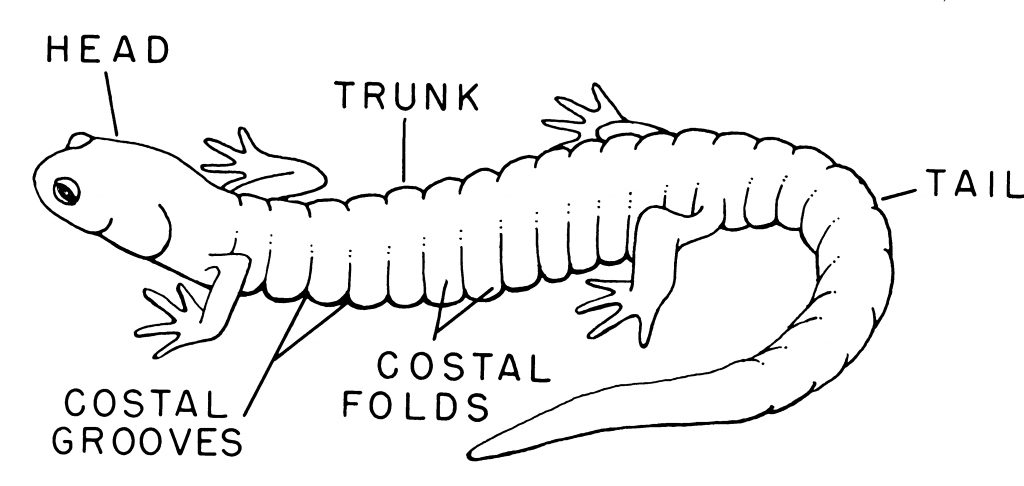
16a. Neck wider than head; snout very short; lower jaw projecting slightly beyond upper jaw (Fig. 6a) … Small-mouthed Salamander
16b. Head wider than neck; snout long and broad; lower jaw not projecting beyond upper jaw (Fig. 6b) … 17

17a. All or nearly all individuals female; known from a few locations in Vermilion and Crawford Counties … Silvery Salamander
17b. Males and females present; not known from Vermilion County … 18
18a. Ground color black or nearly so; dorsum and sides heavily marked with small bluish spots, vent surrounded by black … Blue-spotted Salamander
18b. Ground color dark brown to lead gray, dorsum and sides only lightly marked with bluish flecks (usually concentrated along lower sides); vent usually surrounded by gray … Jefferson Salamander
19a. Gill slits (Fig. 2) absent … Neotenic Eastern Newt
19b. Gill slits (Fig. 2) present … 20
20a. Hind legs absent; body eel-like; costal grooves (Fig. 5) number 30 or more … Lesser Siren
(Note: Because larval legs develop gradually after hatching, number of legs is not a useful trait for identifying larvae under about 25 mm total length.)
20b. Hind legs present; body not eel-like; costal grooves (Fig. 5) fewer than 30 … 21
21a. Upper fin low and limited to the tail (Fig. 7a) … 22
21b. Upper fin high and extending well onto the trunk anterior to the vent (Fig. 7b) … 26
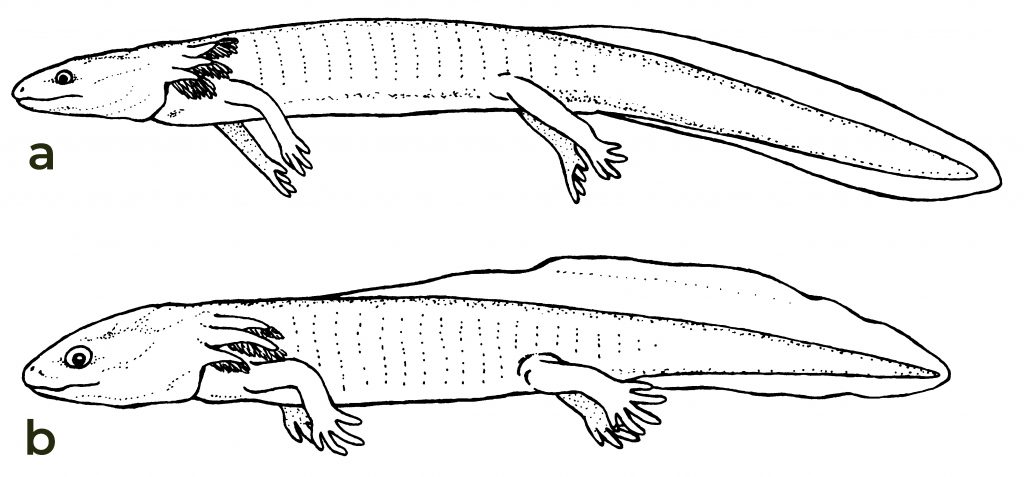
22a. Mid-dorsal stripe always present, dark, and bordered on each side by a light stripe; open gill slits (Fig. 2) … Mudpuppy
22b. Mid-dorsal stripe, if present, light and not bordered by a light stripe; open gill slits (Fig. 2) 3 or 4 … 23
23a. Four gill slits (Fig. 2); gill rami shorter than gill filaments (Fig. 7a); gills glistening white … Spotted Dusky Salamander
23b. Three gill slits (Fig. 2); gill rami much longer than filaments (Fig. 7b); gills pigmented … 24
24a. Throat darkly pigmented on anterior half only (Fig. 8a); body pigment encroaching onto the venter beyond bases of limbs; bottoms of hind feet pigmented … Cave Salamander
24b. Throat unpigmented or only sparsely pigmented on anterior half (Fig. 8b); body pigment not encroaching onto venter beyond bases of limbs; bottoms of hind feet not pigmented … 25
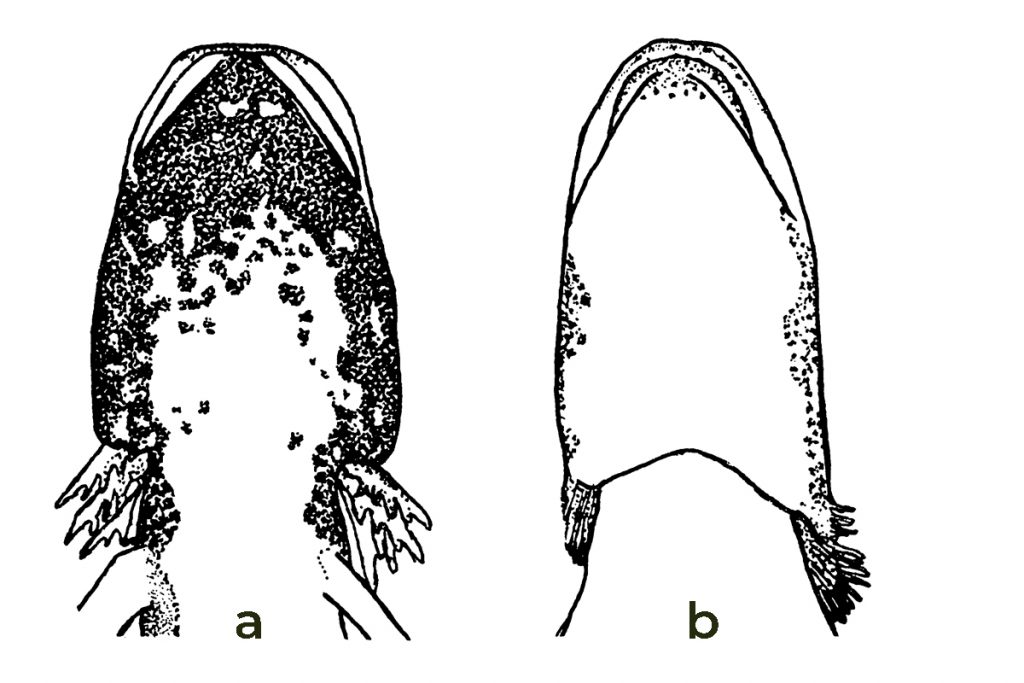
25a. Dorsum marked with a series of paired light spots, which may fuse with a mid-dorsal light stripe; throat pigment absent … Southern Two-lined Salamander
25b. Dorsum marked with a light stripe, never paired light spots; throat pigment usually sparse and restricted to the anterior third (Fig. 8b) … Long-tailed Salamander
26a. Gill slits (Fig. 2) in 3 pairs; never more than 4 toes on hind feet … Four-toed Salamander
(Note: The number of toes is not a reliable trait for distinguishing small Four-toed Salamander larvae from small larval Ambystoma that are still developing.)
26b. Gill slits (Fig. 2) in 4 pairs; 5 toes on hind feet … 27
27a. Costal grooves (Fig. 5) absent; side of the head with dark stripe that continues through the eye … Eastern Newt
27b. Costal grooves (Fig. 5) present; side of the head without dark stripe that continues through the eye … 28
28a. Throat well pigmented (Fig. 8a) … 29
28b. Throat without pigment or with pigment bordering jaws only (Fig. 8b) … 31
29a. Dorsum of small larvae without dark, transverse bands; sides of body with light spots; venter uniformly covered with small dots of pigment … Marbled Salamander
29b. Dorsum of small larvae with dark, transverse bands; sides of body without light spots; venter not uniformly covered with small dots of pigment … 30
30a. Costal grooves (Fig. 5) number 14-16; venter unpigmented or with a narrow midline of pigment; side of head of small larvae without dark stripes … Small-mouthed Salamander
30b. Costal grooves (Fig. 5) number 10-11; venter with dark central stripe bordered by light stripes; side of head of small larvae with 1 or 2 dark stripes … Mole Salamander
31a. Toes flattened, broad at base, and pointed at tip … Eastern Tiger Salamander
31b. Toes not flattened, broad at base, or pointed at tip … 32
32a. Head conspicuously large and much wider than the trunk; tail fin intensely pigmented and mottled with black; dorsum of small larvae with dark transverse bands … Jefferson, Blue-spotted, or Silvery Salamander
32b. Head not notably large nor much wider than the trunk; tail fin not intensely pigmented or distinctly mottled; dorsum of small larvae without dark transverse bands … Spotted Salamander
